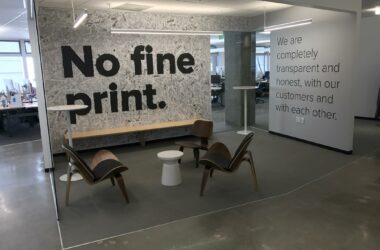It’s close to the end of another year, which makes for a good excuse to take stock of these last 12 months, take a deep breath, before charging forward into 2022. Unfortunately, COVID-19 is still very much a part of our lives and some ways the new normal; the delineation between pandemic and post-pandemic gets increasingly blurry by the day.
As I gathered my thoughts and coalesced them into this post, I’m struck by how much this year has been about major, almost fundamental shifts at a global, societal scale—much more so than years past. Certainly, these end-of-year posts are an exercise in self-reflection, but I can’t help but feel like that, for 2021, I’ve just been along for the ride.
For reference, here’s last year’s Year in Review – 2020, and the collection of blog posts here for the entirety of 2021.
Still COVIDing
It was probably too much to hope—remember, the mRNA vaccines exceeded efficacy expectations by a lot—that the pandemic would be over some time this year. COVID-19 is, of course, still very much with us; as I’m writing this, we’re still learning about the new Omnicron variant of the virus and how fast it’s spreading in various hotspots around the world.
Humanity is good at adaptation, and through almost 2 years of living with COVID, some things have started to feel normal for better and for worse. These new behaviors may very well imprint themselves into our lives due to sheer momentum, things like: keeping masks and sanitizers handy; more working from home for those able to do so; more deliveries, of both the food and retail good varieties; tighter supply chains and more acute shortages. Admittedly, I was too naïve last year in assuming that the global community would use the pandemic as a blueprint, a playbook for tackling other major issues we face; that has decidedly not materialized in the past 12 months. Most of the enduring impact have been in areas directly related to dealing with the virus itself, or due to the restrictions to limit viral spread.
I’m pretty certain I’ll still be writing about COVID by the end of 2022. In studying history and human behaviors through previous times of disease, societies stay conservative and keep up with preventive procedures even well after an epidemic has run its course. Sadly, we are unlikely to reach even that point, as we are dealing with a pandemic, and global vaccine distribution and availability remains uneven and unequal.
Finance Meets the Internet
Last year, I wrote about how the stock market rebounded from its Coronavirus fears in March to all-time highs only a few months later, and propelled an impressive number of businesses upwards while encouraging many large startups to try the public markets, either through traditional IPOs or via more esoteric SPAC vehicles1. Case in point, the fintech company I worked at for 3.5 years did manage to go public early in the year.
But the real finance story of the year is the rise of financial trends orthogonal to any sort of traditional financial methodologies, fundamental or technical analyses or swing trades or hedge trades or anything that Wall Street has engineered so far. It’s the year of meme finance—of a whole bunch of retail traders moving the markets with some combination of internet-based coordination and in-jokes, along with an overarching sense of sticking it to greedy short sellers. It drove up Gamestop stock prices so high that hedge funds lost billions, then piled onto AMC and propped up its market capitalization, then kept the bankrupted car rental company Hertz alive. Oh, and all the while, bullish investors made Tesla the most valuable car company in the world, worth more than all other car manufacturers combined.
Memes now have a real and sustained effect on our financial systems.
The other obvious intersection of internet and finance has been the continued evolution of crypto, and the speed at which the movement has been recreating a parallel set of financial systems with its own twists. There’s the rise of NFTs; a lot more DeFi2 applications; a Chinese Bitcoin ban that scattered mining to the rest of the world; more traditional finance players intermingling and enabling access to the crypto ecosystem; and, of course, plenty of scams and price volatility.
I’m hardly the crypto expert and I don’t own any crypto assets myself3. I just find it fun to follow the developments of the ecosystem from afar, as it continues to evolve. Once in a while, I’ll go through the exercise of trying to apply core financial concepts—picked up through my time at Square and Affirm—to new developments, yet more often than not, I fail to understand how it works.
The Supply Chains
This was the year we all learned what supply chains are! There was that giant container ship that got stuck for a few days at the Suez Canal that initially gave birth to memes but soon caused a damaging chain of shipping delays around the world. The lack of microchips kept the new Xbox and PlayStation 5 consoles, along with PC graphics cards, persistently out of stock, though they keep showing up on eBay for double the MSRP. Cars have gotten so expensive that they single-handedly drove a chunk of the month-over-month inflation rate over the summer. News of container ships lining up to unload cargo kept on making the news throughout the year.
Yet somehow, at least according to one consulting firm, domestic deliveries of packages have fared pretty well this holiday season4.
The lesson to be learned, supposedly, is that our global chain of supplies has optimized away resilience, and something as disruptive as a pandemic exposes all the weaknesses of this complex system. The reaction has been to build more redundancies stateside, but I’m not convinced that it’s a permanent change; the capitalist construct that prioritizes short- and medium-term corporate profits is generally unable to adjust for rare, global catastrophes.
It is up to governments to build better supply chains. To be fair, there has been some movement to towards replicating production domestically, but catalysts are easily found elsewhere: investing in microprocessor plants stateside, for instance, has been driven moreso by concerns around national security and geopolitics than strengthening the supply chain itself. My suspicion—and I hope I’m totally wrong on this—is that the efficiency of movement of goods and services won’t return to pre-COVID levels for years after COVID itself subsides.
Housing is Hard
There are two stories to tell about housing, one for each COVID year.
2020 was about people in cities escaping to suburban and rural areas, to get to less dense living situations and avoid getting sick5 but to also have more living space as cities locked down. It was the story of how AirBnb went from being a travel company for a world that couldn’t travel anymore, to a short-term rentals company for newly-remote office workers looking to get away from their previously cramped apartments.
2021 has been more about just the absolute lack of housing supply coupled with increasing demand due to shifts in consumer spending. It’s the lack of home construction carried over from the 2008 housing bubble crisis finally resulting in a housing supply crunch and abnormally low inventory. It’s the increased cost of labor, plus now premiums demanded6 for building materials from the aforementioned supply chain disruptions. It’s also people having more money to spend—with travel and events stymied in the pandemic—plus a suddenly booming stock market providing even more discretionary income to spend. Low interest rates has kept the party going for longer still.
All of this has made the real estate market tremendously competitive. We ended up experiencing both sides of housing transactions this year: we sold a rental property through Opendoor, and on the other side leveraged an unexpected Affirm IPO to move to a new neighborhood during COVID-induced homeschooling to minimize disruption for the kids.
As a seller, going through a semi-automated, hands-off “iBuying” selling experience was not quite as easy as advertised, but still less hassle than a regular real estate transaction. Prices were indeed competitive7, though there’s a number of fees and commissions that weren’t obvious with the initial engagement. I’d hesitate from buying from companies flipping at scale, though; the impersonal nature of the business means that they’re looking to streamline sales for speed and throughput more than quality.
As a buyer, it was indeed a tough market with many aggressive buyers. I knew people who gave up after trying a couple of losing offers, and others who like us just kept on trying anyway and eventually lucked out. There is a follow-on challenge: a shortage of labor and construction materials plus aforementioned supply chain delays means that any sort of home renovation takes longer and costs more. It’s this raw cost of building and updating homes that feels structural and may very well contribute to elevated housing prices for years to come.
Moar EdTech
On a more personal level, I spent most of 2021 exploring and understanding the intersection of technology and education. I had joined the team at Mystery Science at the tail end of 2020 and got to think about our core educational product, but left in the summer and felt like I didn’t quite spend enough time in the industry to formulate an informed opinion on EdTech. To those ends, after taking a break to buy and renovate our new family home, I looked again at education startups and joined the team at Kiddom.
EdTech reminds me a bit of HealthTech. There are some similarities on the surface: both domains intrinsically offers noble, mission-driven work, require some amount of pedagogical/medical expertise to pair with us technologists, and are generally underindexed in leveraging software to improve efficiencies. Where the money comes from, though, differs widely between the domains. The structure of insurance and healthcare providers are particularly challenging in healthcare, while the funding in education is unique, with various levels of government spending for kids in the K–12 grades but via student loans and elevated tuitions for international students at the college levels.
Through the pandemic, teachers have been hurting and looking to quit the profession, and through my own kids’ schooling I see and sympathize with educators and the additional burdens of teaching remotely. At the same time, teachers and principals and administrators are skeptical of tech, and with good reason; folks like us in Silicon Valley have a bad habit of painting with too broad of a technological brush without fully appreciating teachers’ and students’ needs and build expensive solutions that don’t solve the actual problems. Why is the right software not being built? Well, I’m trying to figure that out.
Tangentially, my other passion relating to education is career mentorship and training; I’ve been volunteering as a mentor for a number of years and I have some interviews to that effect. This year, I’ve been fortunate enough to participate in a handful of angel investments for startups focused on this space; not necessarily because I’m looking for outsized returns on capital, but because I do believe in furthering careers and normalizing services that can help our industry get there faster. I’m happy to see the commitment now put into supporting software engineers’ 8 careers, and I’m optimistic that these efforts will elevate our entire discipline.
On SPACs, their popularity seems to have come and gone in a year’s time.↩
Decentralized Finance, as the collection of concepts are known.↩
My exposure to the asset class would be primarily through my shares in Square—now Block.↩
My anecdotal experience says otherwise; Fedex Ground has lived up to its name recently, in grounding all my packages for an extra week or two.↩
Remember how early on, the COVID outbreak in New York was blamed on its density?↩
The great lumber spike of 2021 happened, subsided, and is apparently happening again.↩
And as it turned out for Zillow, perhaps too competitive.↩
And engineering managers, of course.↩




